Elon University’s Director of Design, Carolyn Nelson, has won numerous awards for graphic design work that has helped to communicate Elon’s character, values and vision for higher education to a wide-array of university constituencies for more than 20 years. But she’s also an accomplished artist whose hand stitched textile collages have been shown in more than 25 exhibits across North Carolina, including most recently at Greensboro’s Gallery 115 in December of 2009 and at the Center for Creative Leadership, through an exhibit that opened August 27.
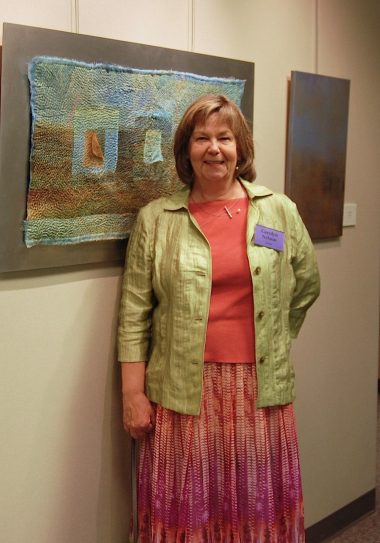
Nelson dyes or paints most of the fabrics she uses, working through a “shibori resist technique,” giving cloth a three-dimensional form through layered fabrics and heavy hand stitching. The diverse fabrics and stitching in her works create depth, movement and form expressing an overall energy or aura unique to each piece.
The subject matter of Nelson’s artistry is informed by international travel and inspired by the forests and wetlands of North Carolina. Since 2005, she has traveled in the Western and Southern United States, as well as to France, Italy and Namibia.
“I always create work from inspiration I find in those places, but I travel to experience different cultures,” Nelson says. “When I search for inspiration, I go to the woods, to bodies of water, to fields here in North Carolina. The black marshes at Nags Head hypnotize me. The ultimate fiber installation. When I need inspiration, it’s always close by.”
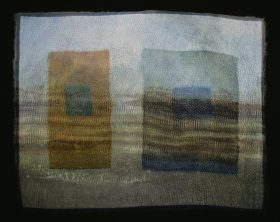
Many of Nelson’s works evoke an essential feeling about each place, whether a marsh, a mesa, or a desert, through abstract depictions of their geography, climate, light and atmosphere.
“Most of my work is deeply grounded in a sense of place – the colors, the light, the textures – but most importantly the energy and the spirit of place,” Nelson says. “It’s about the mystery, a combination of elements that are visible and meaning that cannot be spoken of in words.”
Nelson’s most recent collage series includes embedded garments from her youth. One, titled “Heritage: I” includes a dress her grandmother made in preparation for Nelson’s birth. In the work, one sees the rich history of Nelson’s relationship to textile arts and her current mastery of the medium to evoke matters of the spirit for those who view the work.
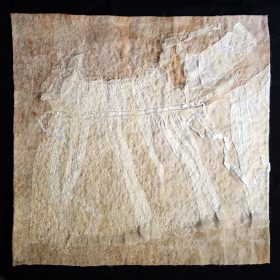
“Sewing is family heritage,” Nelson explains. “My mother and grandmother were talented seamstresses so it was a natural pastime, as well as a means to an end, to make stylish clothes that I couldn’t afford to buy or appliqué pillows to match my sofa. It wasn’t art. But I loved doing it. I loved the colors and textures. I loved the touch and the structure of fabric. And the stories in them, the stories of cultures that are embedded in textiles — block prints from India or batiks from Bali or shibori from Africa or silks from China. There was a rich exotic world in textiles that didn’t exist in my eastern North Carolina life.”
With a Bachelor of Fine Arts from the University of North Carolina at Greensboro and a Masters in Visual Design from the College of Design at North Carolina State University, Nelson has been a professional artist for much of her adult life, as well as a visual design instructor at both institutions where she earned degrees, and a graphic designer. She says her entry into the use of textile collage as art, rather than craft object, began after her son, Brinkley Messick, also an accomplished artist, went to college, and after what she called an “art-making drought.”
“I expected to jump back in where I left off as an artist doll maker,” Nelson said. “But all I could do was paint rooms. One day, I accompanied the Elon photographer to shoot an exhibit of student work based on international crafts. The spirit of the work felt like balm to me, like what I was missing, like what I needed, like medicine. I met the professor, Peg Gignoux, and found out she was teaching at Penland School of Crafts. I came back to my office and applied for her class.”
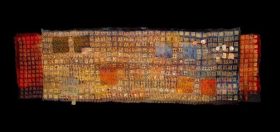
After her time at Penland, Nelson says, she “began to work with the stitch as a mark, just as a pencil or pen makes a mark, with dye as paint and fiber as texture.”
Nelson says she hopes viewers of her art hear something that they don’t have words for in it, that they find some measure of delight in it, or that they are touched in some personal way by it.
“There is much art that is disturbing, that is based on pain or injustice,” Nelson said. “But I’m too old for that now and I’ve seen too much of it. The world doesn’t need me to create more. I don’t want my work to preach or demand or inflame. I just want it to be there if someone cares to spend time with it.”
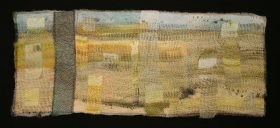
Among numerous locations across the state, Nelson’s work has been exhibited at Green Hill Gallery in Greensboro, ArtSpace in Raleigh as part of the Fine Contemporary Crafts national exhibit, and Horace Williams House in Chapel Hill, where she received the Maude Gatewood Award of Excellence in 2004.
Her works can be viewed through an exhibit at the Center for Creative Leadership in Greensboro throughout the fall.
Click on the E-Cast link to the right of this article to view a slideshow of Nelson’s work or visit carolynnelsonart.com.


